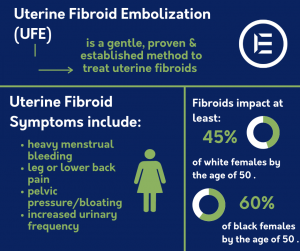
Also known as uterine artery embolization, the process of uterine fibroid embolization (UFE) is a minimally invasive medical process designed to eliminate uterine fibroids by cutting it off from its normal blood supply coming from the uterine arteries. UFE is only one of many different treatments that can be chosen for getting rid of uterine fibroid growths, and many medical practitioners consider it among the most important and effective treatments.
How Does UFE Actually Work?
Many treatments that are either similar to UFE or that tackle the same problem through a different approach are far more invasive and difficult to bear. In contrast, uterine fibroid embolization doesn’t take long to implement, and it also involves fewer possible side effects that have to be taken under consideration.
There are a few important steps to remember about the actual way that UFE is implemented as a treatment:
- Once your doctor establishes the diagnosis of uterine fibroids and you agree to go through the UFE procedure, you will be required to check into the clinic or hospital at a certain date.
- There, you will be required to wear a special gown and to take a pregnancy test, to make sure you’re not expecting. This is done as a precaution due to the fact that UFE requires the use of an X-ray machine for an extended period.
- A local anesthetic and then an injection is applied to either your wrist or to the groin area, depending on your preference of where the procedure should be applied.
- A thin needle and then a plastic tube will be inserted into the correct artery. The tube will inject a special dye that is visible on X-rays and can be used to track the path of the artery and where the blood flows to the uterus.
- Tiny particles of gelatin or plastic are then injected into the correct part of the bloodstream to prevent blood flow to the area of the uterus where the fibroids are located.
Getting Around After the Procedure
Although only minimally invasive, entirely safe and relatively quick, the procedure of UFE can have a few uncomfortable aftereffects. You can typically stand up and walk without a problem just a few hours after the procedure is completed. Also, experiencing some pain is normal due to the loss of blood flow to parts of the uterus. Patients are typically given morphine during the recovery period and asked not to do any heavy lifting.
Some mucous-like or even bloody discharge is also considered normal, and can persist for quite a few days after the procedure is completed. Fortunately, the symptoms that you had experienced as a result of the fibroids as well as the treatment will recede over time. As the fibroids are starved, they will remain on the walls of the uterus for some time, but they will no longer cause harmful symptoms. Also, over time they will shrink and disappear.
As you visit the best local clinic for your diagnosis and treatment, you will experience less discomfort, and the entire procedure will be very smooth and fast. 7-10 days later, you can resume your normal life and even forget about your problems entirely.
